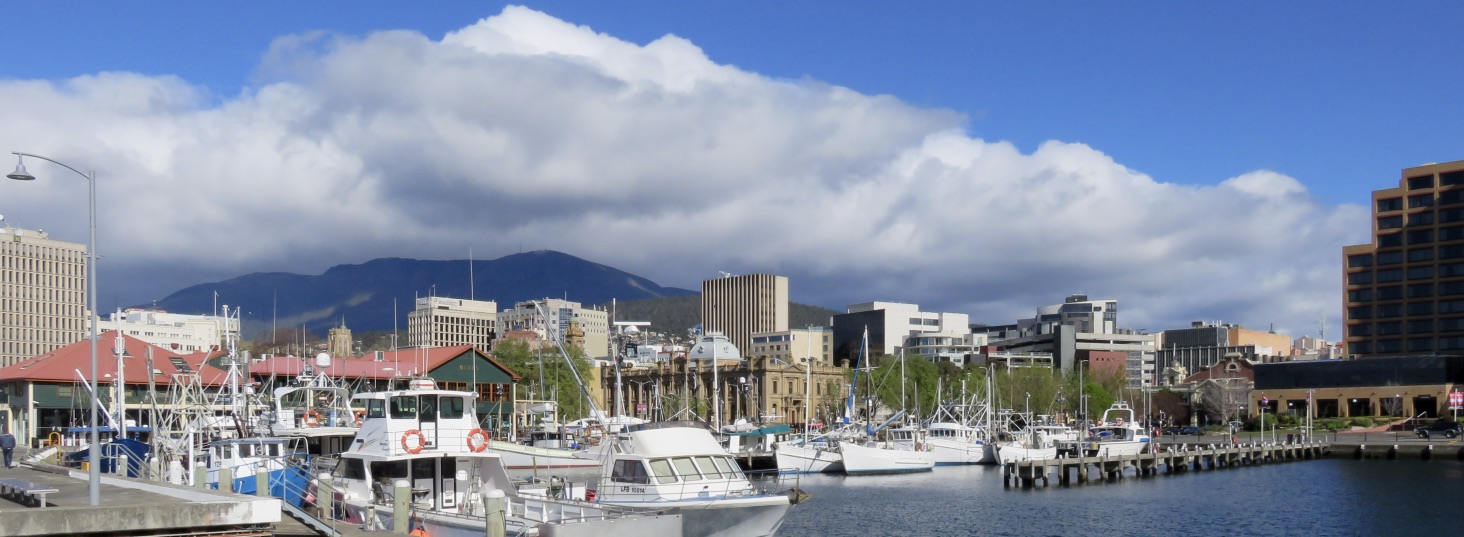
Hobart today
While David mapped out our plans for the day, I wandered the hotel to peruse the artwork and to fantasize about what life must have been like in Sir Henry Jones’s time. I found the following bit of history on the Hunter Street warehouses, framed and hanging on a wall next to an abstract painting, and wanted to share it with my readers. There is some overlap of information from last week’s post, but I hope you find this history as interesting as I do.
William Bunster built Numbers 33 and 31 Hunter Street in the 1820s as a residence and warehouse. He traded in sealskins from Macquarie Island, salt and sealskins from Kangaroo Island, and general merchandise between Hobart and Sydney. As his business expanded he acquired Number 35, and several country properties as well. Unlike many other merchants, he did not build his fortune on initial wealth or family connections. At a dinner given in his honor in the early 1850s he described himself as ‘a plain man . . . I have tried to steer an independent course. I owe nothing to Government nor to any man.’
For much of its life Number 31 was also a tavern. In 1827, it was the Commercial Inn, where Hobart’s first Chamber of Commerce was formed at a meeting of merchants in a room on the first floor, while sailors and wharf laborers drank up their meagre pay in the Shades Tap Room in the basement.
Between 1869 and 1882 Numbers 27–33 were bought in a dilapidated condition by George Peacock, a jam manufacturer. Peacock ran his firm on religious lines, with morning prayers, hymns, and sermons, and strict abstinence from alcohol. Despite these precautions, by 1892 his firm had fallen on hard times. Peacock’s son and two of his employees formed a partnership and bailed out the Old Wharf jam factory. One of his employees was young Henry Jones. Like Peacock before him, Jones lived in Bunster’s old house, Number 33. The other warehouses were the cornerstone of his empire, which grew far beyond Tasmania’s shores.
After the Great Fire of 1890 swept through the whole of Hunter Street from the Drunken Admiral to the site of the old gasworks, now home to the Federation Concert Hall, many of the burned homes were never rebuilt. Others were sold or demolished, and most of the area was replaced with commercial development—contributing to Wapping’s demise as a residential district.
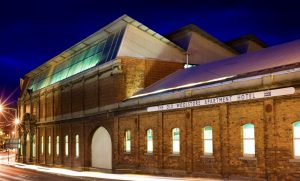
Old Woolstore Apartment Hotel.
Today, Hobart’s seediest district sports one of the town’s tallest high-rise hotels and new walk-up yuppie apartments. But not far from the modern waterfront hotel, I discovered what I hoped to find—restored historical buildings preserved for a new use: the Mantra Collins Hotel, which appears to be part old and part new, and the Old Woolstore Apartment Hotel, which sits on land originally known as Wapping and later referred to as Sullivan’s Cove. Particularly intriguing was the top floor of the Woolstore building with its sawtooth roofline. This style of roofing allowed the maximum amount of natural light into the room, which benefited the wool weavers.
After learning about Henry Jones’s IXL jam factory, my first thought was, “Where did Peacock, and then Jones, get such an abundance of fruit for his jams?” So I did some research. As surprised as I was that the sugarcane industry is one of Australia’s largest and most important industries, I was even more surprised to learn that Tasmania grows an abundance of fresh fruit. In fact, the Tasmanian fruit industry was worth over $102 million in 2010. The major fruit crops grown are apples, pears, cherries, berries, and stone fruit. Although the apple industry has been in decline over the past decade, it still accounts for 25 percent of Tasmania’s fruit production, and the cherry industry is experiencing significant growth.
As an adolescent growing up overseas, it never dawned on me that jam didn’t come in a can. I’m sure I saw jam in a glass container when I lived in Maryland, but I never made a note of that. I also don’t recall ever seeing syrup in any container but a can. Pictured is my favorite syrup—in a can.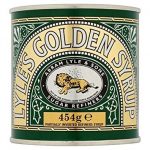
Tasmania also has a significant history of tin production. Tin was discovered in the late 1800s and was the metal of choice. George Peacock sourced his tin from local mines to make the cans for his jams.
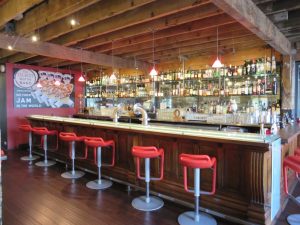
IXL Long Bar at The Henry Jones Art Hotel
An hour later, David hunted me up and we set out to explore the surrounding area, starting at Battery Point, named after the battery of guns established on the point in 1818 as part of Hobart’s coastal defenses. Our goal was simply to walk, and we did—Battery Point, Sandy Bay, University of Tasmania, Cascades Female Factory, St. David’s Park, Salamanca Place and Salamanca Market, Royal Tasmanian Botanical Gardens, and finally the Old Woolstore Apartment Hotel at 1 Macquarie Street. And along the way, we passed the Queen Alexandra Hospital where Errol Flynn was born, and we managed to find time to see Maffra, the Victorian Gothic weatherboard house designed by noted architect Henry Hunter in 1885 and once home to the Hollywood actor.
In the hotel lobby, adjacent to the IXL Long Bar, we sank into one of the cushiony leather sofas, ordered drinks, and relaxed before dinner at the Peacock and Jones. I had the duck and foie gras and bitter leaf salad with truffle vinaigrette. David chose the Huon Valley beef with horseradish, smoked tongue, and pommes dauphine.
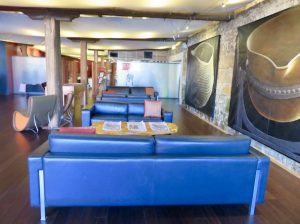
Lobby of The Henry Jones Art Hotel


0 Comments